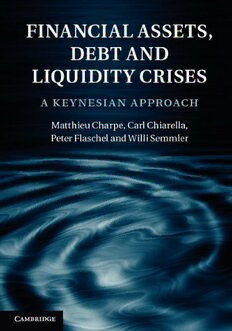
Financial Assets, Debt and Liquidity Crises: A Keynesian Approach PDF
Preview Financial Assets, Debt and Liquidity Crises: A Keynesian Approach
FinancialAssets, Debt and Liquidity Crises The macroeconomic development of most major industrial economies is characterised by boom-bust cycles. Normally such boom-bust cycles are driven by specific sectors of the economy. In the financial meltdown of the years 2007–9 it was the credit sectorandthereal-estatesectorthatwerethemaindrivingforces. This book takes on the challenge of interpreting and modelling this meltdown. In doing so it revives the traditional Keynesian approach to the financial–real economy interaction and the busi- nesscycle,extendingitinseveralimportantways.Inparticular,it adoptstheKeynesianviewofahierarchyofmarketsandintroduces adetailedfinancialsectorintothetraditionalKeynesianframework. The approach of the book goes beyond the currently dominant paradigm based on the representative agent, market clearing and rational economic agents. Instead it proposes an economy popu- latedwithheterogeneous,rationallyboundedagentsattemptingto copewithdisequilibriainvariousmarkets. matthieu charpe works as an economist for the Interna- tional Institute for Labour Studies at the International Labour OrganizationinGeneva. carl chiarellaisEmeritusProfessorandProfessorofQuan- titative Finance in the School of Finance and Economics at the UniversityofTechnology,Sydney. peter flaschel is Emeritus Professor in the Faculty of Eco- nomicsatBielefeldUniversity. willi semmlerisProfessorofEconomicsatTheNewSchool forSocialResearch,NewYork. Financial Assets, Debt and Liquidity Crises: A Keynesian Approach Matthieu Charpe Carl Chiarella Peter Flaschel Willi Semmler cambridge university press Cambridge,NewYork,Melbourne,Madrid,CapeTown, Singapore,SãoPaulo,Delhi,Tokyo,MexicoCity CambridgeUniversityPress TheEdinburghBuilding,CambridgeCB28RU,UK PublishedintheUnitedStatesofAmericabyCambridgeUniversityPress,NewYork www.cambridge.org Informationonthistitle:www.cambridge.org/9781107004931 ©CambridgeUniversityPress2011 Thispublicationisincopyright.Subjecttostatutoryexception andtotheprovisionsofrelevantcollectivelicensingagreements, noreproductionofanypartmaytakeplacewithoutthewritten permissionofCambridgeUniversityPress. Firstpublished2011 PrintedintheUnitedKingdomattheUniversityPress,Cambridge AcataloguerecordforthispublicationisavailablefromtheBritishLibrary LibraryofCongressCataloginginPublicationdata Financialassets,debt,andliquiditycrises:aKeynesianapproach/MatthieuCharpe...[etal.]. p. cm. Includesbibliographicalreferencesandindex. ISBN978-1-107-00493-1 1. Macroeconomics. 2. Businesscycles. 3. Financialcrises. 4. Keynesianeconomics. I. Charpe,Matthieu. HB172.5.F5162011 (cid:1) 330.90511–dc22 2011011256 ISBN978-1-107-00493-1Hardback CambridgeUniversityPresshasnoresponsibilityforthepersistenceor accuracyofURLsforexternalorthird-partyInternetwebsitesreferredtoin thispublication,anddoesnotguaranteethatanycontentonsuchwebsitesis, orwillremain,accurateorappropriate. Contents Listoffigures pagex Listoftables xiv Notation xvi Preface xxi 1 Financialcrisesandthemacroeconomy 1 1.1 Openeconomies,foreigndebtandcurrencycrises 2 1.2 Householdborrowing,debtdefaultandbankingcrises 5 1.3 Overleveraging,debtanddebtdeflation 8 1.4 Planofthebook 10 PartI Thenon-lineardynamicsofcreditanddebtdefault 13 2 Currencycrisis,creditcrunchesandlargeoutputloss 15 2.1 Theemergenceofcurrencycrises 15 2.2 Somestylisedfacts 16 2.3 TheKrugmanmodel:anMFTrepresentation 17 2.4 Sectoralbudgetequationsandnationalaccounts 23 2.5 Flexibleexchangerates:outputandexchangeratedynamics 29 2.6 Fixedexchangeratesandtheemergenceofcurrencycrises 36 2.7 Internationalcapitalflows:addingcapitalaccountdynamics 42 2.8 Conclusions 48 3 Mortgageloans,debtdefaultandtheemergenceofbankingcrises 50 3.1 Mortgageandbankingcrises 50 3.2 AKeynes–Goodwinmodelwithmortgageloansanddebtdefault 52 3.3 Excessiveoverconsumptionandanattractingsteadystate 55 3.4 Weaklyexcessiveoverconsumptionandarepellingsteadystate 62 3.5 Creditrationing,reducedconsumptionandtheemergenceof mortgagecrises 65 v vi Contents 3.6 Monetarypolicyinamortgagecrisis 67 3.7 Addingcommercialbanking 71 3.8 Conclusionsandoutlook 77 3.9 Appendix:somesimulationstudiesofthebaselinemodel 78 4 Debtdeflationandthedescentintoeconomicdepression 85 4.1 Thedebtdeflationdebate 85 4.2 3Ddebtaccumulation 88 4.3 4Ddebtdeflation 100 4.4 Keynes–Metzler–Goodwinrealbusinessfluctuations:thepointof departure 111 4.4.1 Thebasicframework 112 4.4.2 The3DRosetypewage-pricedynamics 113 4.4.3 The2DMetzlerianquantitydynamicsandcapitalstock growth 116 4.4.4 Puttingthingstogether:theKMGgrowthdynamics 117 4.5 Feedback-motivatedstabilityanalysis 119 4.6 DebtdeflationintheKMGframework 124 4.6.1 Integratingdebtfinancingoffirms 125 4.6.2 EnterprisedebtdynamicsintheKMGframework 127 4.6.3 Analysisofthemodel 128 4.7 Conclusionsandoutlook 132 PartII Theoreticalfoundationsforstructuralmacroeconometric modelbuilding 133 5 Keynesianmacroeconometricmodelbuilding:apointofdeparture 135 5.1 Introduction 135 5.2 Therealandthefinancialpartoftheeconomy 139 5.2.1 Thestructureoftherealpart 139 5.2.2 Thestructureofthefinancialpart 140 5.3 Thestructureoftheeconomyfromtheviewpointofnational accounting 142 5.3.1 Thefoursectorsoftheeconomy 142 5.3.2 Grossdomesticproduct,savings,investmentandfurther aggregates 148 5.4 Themodel 151 5.4.1 Preliminaries 152 5.4.2 Households 155 5.4.3 Firms 161 5.4.4 Thegovernment 164 5.4.5 Quantityandpriceadjustmentprocesses 168 Contents vii 5.4.6 Thedynamicsofassetmarketpricesandexpectations 171 5.4.7 Externalaccountsandforeigncountrydata 176 5.5 Thenextsteps 178 6 Intensiveformandsteadystatecalculations 180 6.1 Introduction 180 6.2 Therealandthefinancialstructureontheintensiveformlevel 181 6.2.1 Therealpartoftheeconomy 181 6.2.2 Thefinancialpartoftheeconomy 182 6.3 Theimplied34Ddynamics 183 6.3.1 Thelawsofmotion 184 6.3.2 Staticrelationships 190 6.4 Steadystateanalysis 192 6.5 The18Dcoredynamicsofthemodel 197 6.5.1 Thelawsofmotion 198 6.5.2 Staticrelationships 200 6.6 Outlook:feedbackstructuresandstabilityissues 201 7 Partialfeedbackstructuresandstabilityissues 206 7.1 Introduction 206 7.2 Nationalaccounting(inintensiveform) 207 7.2.1 Firms 207 7.2.2 Assetholders 209 7.2.3 Workers 209 7.2.4 Fiscalandmonetaryauthorities 209 7.2.5 Internationalrelationships 210 7.3 Thecore18Ddynamicalsystem:arecapitulation 211 7.4 AGoodwinwageincome/insider-outsiderlabourmarket dynamics 216 7.5 AddingtheRoserealwagefeedbackchain 219 7.6 TheMetzlerianexpectedsales/inventorydynamics 224 7.7 Thedynamicsofhousingsupply 228 7.8 TheKeyneseffect 230 7.9 TheMundell–Tobineffect 232 7.10 TheBlanchardbondandstockmarketdynamics 234 7.11 Thedynamicsofthegovernmentbudgetconstraint 240 7.12 Importtaxation 242 7.13 TheDornbuschexchangeratedynamicsmechanism 243 7.14 Conclusions 248 PartIII Debtcrises:firms,banksandthehousingmarkets 251 8 Debtdeflation:fromlowtohighordermacrosystems 253 8.1 Introduction 253 viii Contents 8.2 Reformulatingthestructureoftheeconomy 260 8.2.1 Changesinthefinancialsectoroftheeconomy 261 8.2.2 Changesfromtheviewpointofnationalaccounting 261 8.3 Theaugmented18+2Dsystem:investment,debtandprice leveldynamics 266 8.4 Intensiveformrepresentationofthe20Ddynamics 273 8.5 Debteffectsanddebtdeflation 282 8.5.1 3Ddebtaccumulation 283 8.5.2 4Ddebtdeflation 287 8.6 Numericalsimulations:fromlowtohighorderdynamics 294 8.6.1 The3Ddynamics 294 8.6.2 The4Ddynamics 296 8.6.3 The20Ddynamics 300 8.7 Summaryandoutlook 304 9 Bankruptcyoffirms,debtdefaultandtheperformanceofbanks 307 9.1 Debttargeting,debtdefaultandbankruptcy 309 9.2 Tabularrepresentationsofstocksandflows 311 9.3 Commercialbanksandpro-cyclicalcreditsupply 313 9.3.1 Firms 313 9.3.2 Commercialbanks:creditrationingandmoneycreation 317 9.3.3 Assetholders:Blanchardassetmarketdynamics 320 9.3.4 Publicsector 321 9.3.5 Workers 323 9.4 Reducedformequationsandsteadystate 325 9.5 Debtdefaultwithoutandwithbankruptcy 327 9.5.1 Debtdefaultwithoutbankruptcy 328 9.5.1.1 Thecaseofawage-ledaggregatedemand 330 9.5.1.2 Thecaseofaprofit-ledaggregatedemand 332 9.5.2 Debtdefaultwithbankruptcy 333 9.5.2.1 Thecaseofawage-ledaggregatedemand 335 9.5.2.2 Thecaseofaprofit-ledaggregatedemand 336 9.6 Simulations:baselinescenarios 338 9.6.1 Debtdefaultandbankruptcy 338 9.6.2 Banks’budgetconstraint 339 9.6.3 Pro-cyclicalprofitsandcreditsupply 340 9.6.4 Debtdefaultandcreditcrunch 341 9.6.5 Bankbailoutsandlosssocialisation 342 9.7 Simulations:extendedstudies 343 9.7.1 Wage-ledaggregatedemand 343 9.7.2 Profit-ledaggregatedemand 346 9.7.3 Debtdeflation 347 Contents ix 9.7.4 Interestratepolicyrules 349 9.7.5 Fiscalpolicy 351 9.8 Conclusions 352 10 Japan’sinstitutionalconfigurationanditsfinancialcrisis 354 10.1 Astableprofit-ledrealsector 356 10.2 Pro-cyclicalfinancialmarkets 360 10.3 Lessthanoptimalfiscalandmonetarypolicies 362 10.4 Debtdefaultwithoutbankruptcy 365 10.5 Baddebtandbankingcrises 367 10.6 Delayedandweakgovernmentresponse 368 10.6.1 Theearlyresponse:buy-inoffailingbanks 370 10.6.2 Theineluctablebuy-outoffailingbanks 372 10.7 Conclusions 378 10.8 Appendix:datasources 379 11 Housinginvestmentcycles,workers’debtanddebtdefault 380 11.1 Introduction 380 11.2 Debtrelationshipsinthehouseholdsector 382 11.2.1 Workerhouseholds 382 11.2.2 Pureassetholderhouseholds 385 11.2.3 Wage,priceandinterestrateadjustmentprocesses 388 11.3 Intensiveformderivationofasimplified9Ddynamics 389 11.4 2D,3Dand5Dsubcasesofintegrated6Drealsubdynamics 397 11.5 Numericalinvestigationofhousingcyclesanddebtdeflation 410 11.6 Debtdefaultandbankruptcyintheprivatehousingmarket 414 11.7 Conclusions 419 References 420 Index 427
